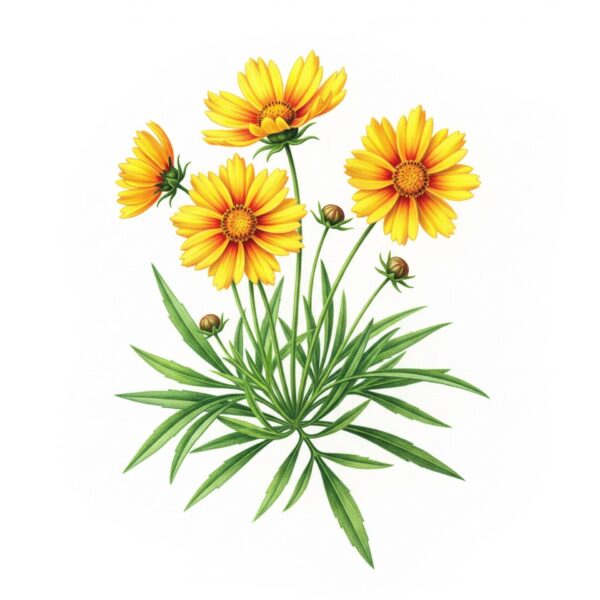Coreopsis, commonly known as tickseed, is a popular genus of flowering plants native to North, Central, and South America. Valued for its cheerful, daisy-like flowers and long blooming season, it is a low-maintenance and versatile plant for a wide range of garden settings. The common name “tickseed” comes from the small, dry seeds, which were thought to resemble ticks.
Description
Key Characteristics:
- Size: Coreopsis plants vary greatly in size depending on the species and cultivar, ranging from compact varieties that are 6 inches tall to taller types that can reach 4 feet or more.
- Habit: They typically form upright, mounding, or clumping habits. Some species, like Coreopsis verticillata, have a more airy, delicate appearance, while others are more bushy.
- Leaves: The foliage is bright green, but its texture and shape differ by variety. Leaves can be deeply lobed, lance-shaped, or finely-textured and lacy (as in the threadleaf coreopsis).
- Flowers: The most striking feature of coreopsis is its abundant daisy-like flowers. While the most common colour is sunny yellow, new cultivars have introduced a wide spectrum of colours, including shades of orange, pink, red, white, and various bicolors. The flowers can be single, semi-double, or double and often have a contrasting center.
- Blooming Season: Coreopsis is celebrated for its long and prolific bloom time, typically from early summer through fall, with consistent deadheading encouraging continuous flowering.
Growing Conditions and Uses:
- Sun and Soil: Tickseed is a sun-loving plant that performs best in full sun (at least six to eight hours of direct light per day) but can tolerate partial shade, though with less prolific blooming. It is highly adaptable to various soil types, including sandy and rocky soils, but requires excellent drainage to prevent root rot. It is known for its ability to thrive in poor, lean soils.
- Hardiness and Resilience: Most perennial varieties are hardy. Coreopsis is notably drought-tolerant and also resistant to deer and rabbits, making it an excellent choice for low-maintenance or challenging garden areas.
- Landscaping Uses: Its versatility makes it suitable for many garden applications. It is commonly used in perennial borders, mass plantings, rock gardens, cottage gardens, and containers. The flowers are also excellent for cutting and are a magnet for bees, butterflies, and other pollinators.
Popular Varieties:
The genus includes both perennial and annual species. Some popular perennial types include:
- Coreopsis grandiflora (Large-flowered Tickseed): Features large, golden-yellow flowers and is known for its reliability and long bloom time. ‘Early Sunrise’ and ‘Sunray’ are well-known cultivars.
- Coreopsis verticillata (Threadleaf Coreopsis): Distinguished by its fine, lacy foliage and a cloud of small, yellow flowers. Popular cultivars include ‘Moonbeam’ and ‘Zagreb.’
- Coreopsis rosea (Pink Tickseed): A species with delicate pink flowers, which can be a good choice for adding a different color to the typical yellow coreopsis palette.
| See also different: | Easy-care perennial plants |

